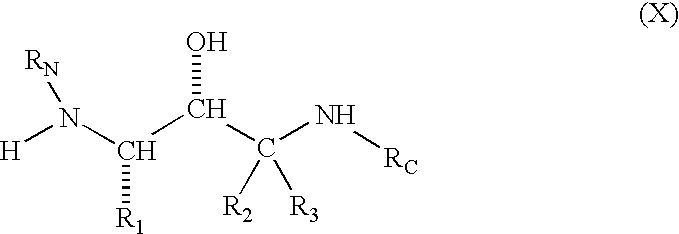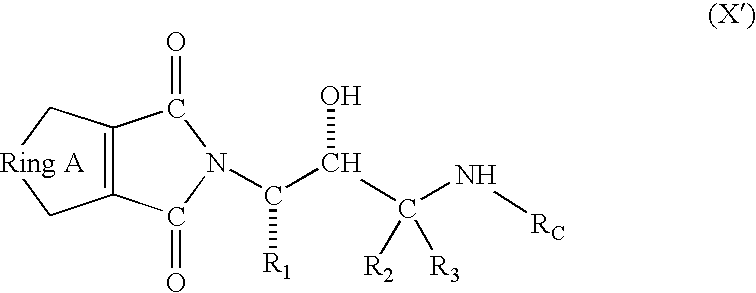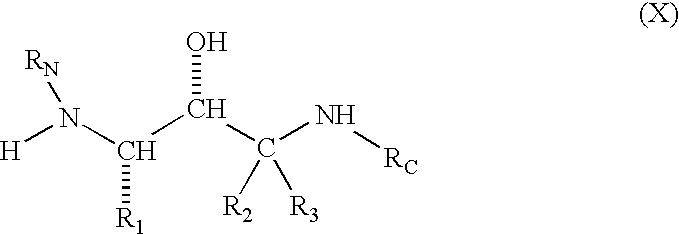Compounds to treat alzheimer's disease
a technology for alzheimer's disease and compounds, applied in the field of compounds to treat alzheimer's disease, can solve the problems of preventing, reversing, and preventing the progression of alzheimer's disease without real success, and achieve the effects of inhibiting the production of beta peptides, and preventing or delaying the onset of alzheimer
- Summary
- Abstract
- Description
- Claims
- Application Information
AI Technical Summary
Benefits of technology
Problems solved by technology
Method used
Image
Examples
examples
[1535] Without further elaboration, it is believed that one skilled in the art can, using the preceding description, practice the present invention to its fullest extent. The following detailed examples describe how to prepare the various compounds and / or perform the various processes of the invention and are to be construed as merely illustrative, and not limitations of the preceding disclosure in any way whatsoever. Those skilled in the art will promptly recognize appropriate variations from the procedures both as to reactants and as to reaction conditions and techniques.
preparation 1
[1536] Preparation 1
[1537] 3-Amino-5-(methoxycarbonyl)Benzoic Acid (XVII)
[1538] A suspension of mono-methyl 5-nitro-isophthalate (22.5 g, 100 mmol) and palladium on carbon (5%, 2.00 g) in methanol (100 mL) is shaken in a hydrogenation apparatus under hydrogen (50 psi) for 3 hours. The mixture is then filtered through diatomaceous earth and concentrated to give the title compound, NMR (300 MHz, CDCl.sub.3) delta 7.67, 7.41, 7.40 and 3.83; MS (ESI-) for C.sub.9H.sub.9NO.sub.4 m / z (M-H).sup.-=194.
preparation 2
[1539] Preparation 2
[1540] 3-Bromo-5-(methoxycarbonyl)Benzoic Acid (XIX)
[1541] A mixture of copper (II) bromide (1.85 g, 8.30 mmol), n-butyl nitrite (1.07 g, 10.4 mmol), and acetonitrile (30 mL) is stirred in a round bottomed flask in a water bath to which a few chunks of ice has been added. 3-Amino-5-(methoxycarbonyl)benzoic acid (XVII, PREPARATION 1, 1.35 g, 6.92 mmol) is added as a slurry in warm acetonitrile (70 mL) over 15 min and the mixture is stirred at 20-25 degrees C. for an additional 2 hour, at which time the mixture is partitioned between dichloromethane and hydrochloric acid (3N). The organic phase is separated and dried over sodium sulfate and concentrated to dryness. Chromatography (silica gel, 125 mL; methanol / dichloromethane, 15 / 85) and concentration of the appropriate fractions gives a solid which is crytallized from methanol to give the title compound in two crops, NMR (DMSO-d.sub.6) delta 3.90, 8.26 and 8.65.
PUM
| Property | Measurement | Unit |
|---|---|---|
| time | aaaaa | aaaaa |
| pH | aaaaa | aaaaa |
| pH | aaaaa | aaaaa |
Abstract
Description
Claims
Application Information
 Login to View More
Login to View More - R&D
- Intellectual Property
- Life Sciences
- Materials
- Tech Scout
- Unparalleled Data Quality
- Higher Quality Content
- 60% Fewer Hallucinations
Browse by: Latest US Patents, China's latest patents, Technical Efficacy Thesaurus, Application Domain, Technology Topic, Popular Technical Reports.
© 2025 PatSnap. All rights reserved.Legal|Privacy policy|Modern Slavery Act Transparency Statement|Sitemap|About US| Contact US: help@patsnap.com



